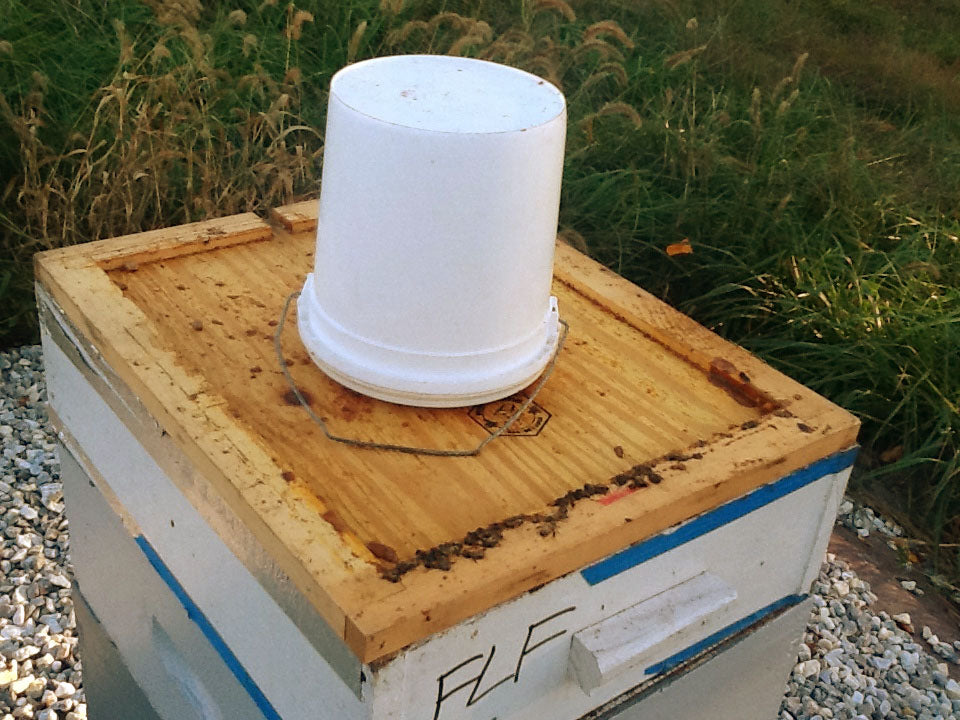October first was a grey chilly day on Kent Island. Time to think about winterizing bees. At 7:30am, it was about 40 degrees; and master beekeeper Dale Large visited to teach me about winterizing the hives.
Everyone has their own ideas of what works and what doesn’t in winterizing bees. On Kent Island, we can have either mild or cold winters depending on the direction of the wind. Dale’s forty-plus years of experience will guide my bees into the winter.
At first glance, I didn’t see much activity outside of the hive, especially no bearding; and when I asked about that, Dale said that the bees don’t like to move much in cold weather. They stay in the hive and keep each other warm. For our inspection, the wax and propolis had hardened from the cold, making opening the hive difficult. We didn’t have much of a fall harvest of honey this year. Between the theft, an earthquake, desert dryness for two months followed by a hurricane and ninety days of rain in late summer, the bees stopped being very productive.
On inspection, we learned we had unwanted guests in our hives: small hive beetles. They can wreak havoc on weak colonies. The adult beetles are only slightly larger than a tick. Female small hive beetles lay eggs inside the hive. Their larvae eat pretty much everything and anything in the hive except for the bees. Eventually, they work their way down and out of the hive heading toward the soil where they will burrow and pupate. They will slime the entire hive on their way out.
The continuously wet weather we had this summer is probably the culprit for our beetles, and the best way to treat them is with beetle traps. We’re using the “hood trap” to capture the adult hive beetles. The traps’ tanks are filled with any combination of olive oil and vinegar to attract the beetles. Hopefully, we’ve caught this early enough, and the adult beetles will drown in the oil and vinegar solution before they can go deep into the hives and do the most damage. Dale did some further research for prevention and had me pour a gallon of household liquid bleach around the base of both hives.
After our inspection, we fed the bees. Bee food is simple syrup.
To prepare for feeding each hive you’ll need:
- a brood box
- two sticks
- 10 lbs of sugar and 1 gallon of warm water
- a feeder




Make the simple syrup by combining 10 lbs of sugar to one gallon of warm water, then pour into the feeder. Make sure you seal the feeder. The bees will take this food in over the following two weeks. When the feeder is empty, it’s important to remove it and the brood box and shut the lid, weighting the lid with bricks.
Keeping pests out of the hive is an important part of winterizing hives. Install the excluder (that we previously used to vent the lid) at the hive entrance to protect the hive from unwanted pests.
Winterizing checklist:
- Check in every 2 weeks for honey production. Stop inspections after temperatures drop below 50 degrees during the day.
- Check for queen, capped and uncapped brood
- Make sure to leave enough honey and supplement food supply if necessary
- Check and be sure drainage (away from hive) is in place
- Remove hive top feeder once it is empty
- Install entrance reducer
- Secure hive lid with rocks or bricks and, if you strap, strap from side to side, not front to back

This was my first season with bees. I enjoyed learning something new and sharing it with other people who are just getting started. We had a very strong start that gave me a lot of hope for raising bees into the future. The most enjoyable part of raising bees has been in sharing the honey with my friends and family. Everyone has enjoyed hearing my stories, and my friends and their children have (in some cases) learned about beekeeping for the very first time.
If you want to learn about how I set up the hives and read about the entire process, start with "On Becoming a Beek".
Next post in this series: On Feeding Bees


